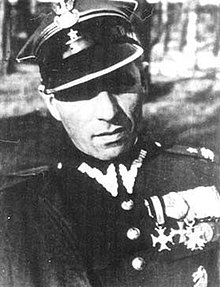Henryk Sucharski
The Polish major Henryk Sucharski (born November 12, 1898 in Gręboszów ; † August 30, 1946 in Naples ) commanded the troops until his replacement by Franciszek Dąbrowski on September 2, 1939 , which at the start of the war the Polish weapons depot Westerplatte in the area of the Free Defended the city of Danzig (Polish: komendant Wojskowej Składnicy Tranzytowej na Westerplatte ).
Life
After attending school in the 2nd KuK grammar school in Tarnów , he completed a cadet training course with the Austro-Hungarian army . In 1919 he joined the Polish army . Under Sucharski, the position in the battle for the Westerplatte was held for seven days by 182 Polish soldiers against the attacks of the shock troops of the ship of the line Schleswig-Holstein and the SS Heimwehr Danzig , his deputy in 1939 was Franciszek Dąbrowski . However, Sucharski's military role is dubious. He was relieved of his position on the evening of September 2nd by Captain Dąbrowski and the officers on account of defeatism and an attempt to surrender . The white flag was removed from the roof of the barracks and the Polish defenders of the Westerplatte continued to hold the position under the leadership of Captain Dąbrowski. Sucharski, on the other hand, appeals to an order to defend the depot for 12 hours if possible, since relief by further troops from the high command was no longer planned. There was no contact with the high command during the defense.
After 1925, the Poles set up an ammunition depot on the Westerplatte, a peninsula at the confluence of the Dead Vistula in the Gdańsk Bay in the area of the Free City of Gdańsk , originally a popular bathing beach for Gdańsk, and partly secretly secured it over the years twenty bunkers. On March 14, 1925, the League of Nations Council allowed Poland to build its own transhipment base for military equipment on the Westerplatte outside the internationalized city and its port. The Council of the League of Nations set the framework for this: the excavation of a harbor basin, the stationing of 88 soldiers (two officers, 20 NCOs and 66 men), up to 30 civilians and the necessary accommodations and warehouses. The construction of defenses was not permitted. The city of Danzig left the site to the Polish state for an unlimited period and free of charge.
On September 1, 1939 at 4:47 am, the " Schleswig-Holstein " began bombarding the Westerplatte with its 280 mm guns when it attacked Poland . With the bombing of Wieluń and these shots, Germany started a new world war. On the afternoon of September 2nd, 40 Ju-87s (Stukas) bombed the Westerplatte. Sucharski surrendered at 10:15 on the morning of September 7th. The German general Friedrich-Georg Eberhardt then returned his saber to the Polish commander Sucharski for the duration of his captivity . A photo with him in Oflag II B Arnswalde (today Choszczno ) shows him in the center of another 30 Polish officers. Before that he was captured in Oflag IV A Hohnstein in Saxony and then in Oflag II D Groß Born (today Borne Sulinowo ). After his liberation by American troops in Schwerin ( Oflag XC Lübeck), he received a command with the II. Polish Corps, 6th Carpathian Rifle Battalion in Italy on January 25, 1946.
Henryk Sucharski died in Naples in 1946 in the British Military Hospital. He was first buried in the Polish military cemetery in Casamassima near Bari. His remains were transferred from there to Gdansk in 1971 and buried on the Westerplatte.
Seven flagpoles still symbolize the seven-day defense there. The monument to the defenders of Westerplatte is a symbol of resistance to many Poles Nazi Germany .
literature
- A. Drzycimski: Major Henryk Sucharski . Wrocław 1990 (Polish)
- Mariusz Borowiak: Westerplatte. W obronie prawdy. GDW, Gdańsk 2001 (Polish)
Dramatizations
- Melchior Wańkowicz: Dwie prawdy
Web links
- Biogram Henryka Sucharskiego (Polish)
- Westerplatte.org (Polish)
- Dr Jerzy Pogonowski, Bój o Lwów (Polish)
Individual evidence
- ^ Melchior Wańkowicz in the English language Wikipedia
| personal data | |
|---|---|
| SURNAME | Sucharski, Henryk |
| BRIEF DESCRIPTION | Polish major |
| DATE OF BIRTH | November 12, 1898 |
| PLACE OF BIRTH | Gręboszów |
| DATE OF DEATH | August 30, 1946 |
| Place of death | Naples |

